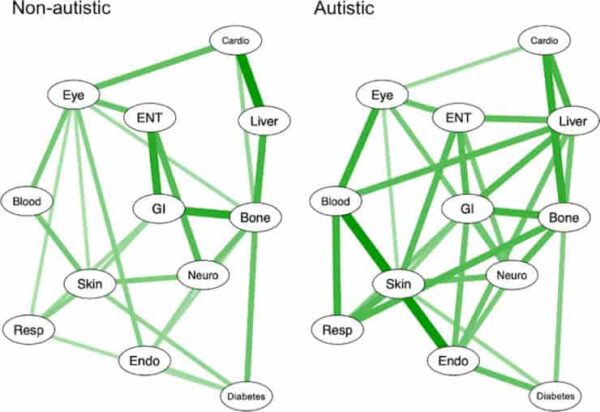A study led by University of Cambridge researchers has found that individuals with autism are more likely to have complex health needs and to have higher rates of chronic physical health conditions occurring throughout the body. The findings have important implications for the clinical care of autistic people.
Numerous physical health issues are more common among individuals diagnosed with an autism spectrum disorder, and they are also dying considerably earlier than the general population, previous research has found. It used to be thought that individuals with autism were more likely to experience particular illnesses, such as digestive discomfort, difficulty sleeping, and epilepsy/seizure disorders.
The new study is different in that it investigated a much wider range of health risks than has been done before and shows that autistic people experience a much broader range of health vulnerabilities than was previously thought.
Increased Health Vulnerability
The study found autistic people are more likely to have physical health conditions across all organ systems, including the brain (such as migraine), the gastrointestinal system (for example, coeliac disease), and the endocrine system (for example, endometriosis), compared to non-autistic people.
“This study emphasizes the increased health vulnerability of autistic people both in the types and number of conditions they may have. We now need to understand the causes of these increased risks, which are likely multifactorial in nature,”
said Dr Elizabeth Weir, a Research Associate at the Autism Research Centre in Cambridge, who led the team.
This is the first study to show that autistic people are more likely than non-autistic people to experience ‘physical health multimorbidity’, meaning that they have at least two or more physical health conditions. These include co-occurring fibromyalgia (which causes chronic pain throughout the body) and polycystic ovarian syndrome (which causes irregular menstrual cycles, infertility, excess hair growth, and acne in women) across different organ systems.
Greater Medical Needs

Credit: Molecular Autism 14, 35 (2023) CC-BY
The study was conducted by a team at the ARC and used an anonymized, self-report survey to compare the experiences of 1,129 autistic people with 1,176 non-autistic people aged 16-90 years. The participants were international, although 67% of participants were from the UK.
The survey assessed the risk of 60 physical health conditions across nine different organ systems (gastrointestinal, endocrine, rheumatological, neurological, ocular, renal/hepatic, otolaryngological, hematological, and dermatological). The analysis took into account other factors such as age, sex assigned at birth, country of residence, ethnicity, education level, alcohol use, smoking, body mass index, and family medical history.
The team found that autistic people were more likely to have diagnosed medical conditions across all nine organ systems tested compared to non-autistic people.
Regarding specific conditions, autistic people had higher rates of 33 specific conditions compared to non-autistic peers. These included coeliac disease, gallbladder disease, endometriosis, syncope (fainting or passing out), vertigo, urinary incontinence, eczema, and iron deficiency anemia.
“This research adds to the body of evidence that the healthcare needs of autistic people are greater than those of non-autistic people. More research is required, particularly surrounding the early identification, and monitoring of chronic conditions,”
Dr John Ward, a visiting research scientist at the ARC in Cambridge, who conducted the analysis, said.
Ehlers-Danlos Syndrome
This is also the first epidemiological study to show that Ehlers-Danlos Syndrome (EDS) – a group of disorders that affects connective tissues and which cause symptoms such as joint hypermobility, loose joints that dislocate easily, joint pain and clicking joints, skin that bruises easily, extreme tiredness, digestive problems, dizziness, stretchy skin, wounds that are slow to heal, organ prolapse, and hernias – may be more common among autistic women than non-autistic women.
The present study replicates earlier findings by demonstrating that, in comparison to non-autistic individuals, those with autism had greater incidence of all central sensitivity syndromes, a diverse collection of disorders linked to central nervous system dysfunction. Examples of central sensitivity syndromes include:
- Irritable bowel syndrome (IBS)
- temporomandibular joint syndrome (TMJ)
- migraine
- tinnitus
- myalgic encephalomyelitis/chronic fatigue syndrome (ME/CFS)
- fibromyalgia
The new study also investigated risks of physical health multimorbidity with a novel application of ‘network analysis’, a technique used to understand relationships between different parts of a system. This analysis method is regularly used in neuroscience to understand how different regions of the brain interact with each other.
Re-evaluation Of Current Health Care Needed
In this study, the analysis assessed how often conditions from different organ systems occurred together in the same person. In addition to highlighting complex health needs, this analysis established for the first time that the combinations of medical conditions that frequently co-occur may be different between autistic and non-autistic adults.
These results are preliminary evidence that healthcare providers such as GPs or family physicians need to be monitoring the healthcare needs of autistic people much more closely.
“These findings highlight the acute need to adapt the healthcare system to better meet the needs of autistic people. These results must be confirmed in larger, population-based samples,”
said Dr Carrie Allison, Director of Strategy at the ARC.
“We are aware of the risks of mental health conditions in autistic people, but this new research identifies their risks of physical health conditions too. We need to urgently re-evaluate current health care systems to improve support for autistic people,”
Professor Sir Simon Baron-Cohen, Director of the ARC and another member of the team, said.
Funding for the project was provided by the Autism Centre of Excellence at Cambridge, the Rosetrees Trust, the Cambridge and Peterborough NHS Foundation Trust, the Corbin Charitable Trust, the Queen Anne’s Gate Foundation, the MRC, the Wellcome Trust and the Innovative Medicines Initiative.
Abstract
Background
The poorer physical health of autistic adults compared to non-autistic adults has been highlighted by several epidemiological studies. However, research has so far been limited to specific geographical areas and has primarily focused on young autistic individuals (aged 35 years and younger). Recent studies indicate a higher rate of mortality in autistic people, as well as poorer quality of self-reported healthcare interactions. This study aims to determine, first, whether autistic people experience greater levels of non-communicable health conditions and second, whether these are explained by differences in demographics (i.e. sex, country of residence, ethnicity, education level), alcohol use, smoking, body mass index (BMI), or family history of medical conditions.
Method
We employed a cross-sectional, convenience-sampling study via an anonymous, online survey of autistic and non-autistic adults (n = 2305, mean age = 41.6, 65.9% female, 49% autistic). The survey asked participants to self-report information about their demographics, autism diagnosis, diet, exercise, sleep, sexual health, substance use, personal medical history, and family medical history (for all first-degree, biological relatives). Binomial logistic regression across four iterative models of increasing complexity was applied to assess rates of physical health conditions. The Benjamini–Hochberg correction was used to account for multiple testing, and only physical health conditions that achieved at least 1% endorsement within the overall sample (n > 22) were included in the analysis to reduce risk of Type I errors. We also used novel network analysis methods to test whether there are increased levels of multimorbidity between autistic and non-autistic people.
Results
There were significantly elevated rates of non-communicable conditions across all organ systems in autistic people, including gastrointestinal, neurological, endocrine, visual, ear/nose/throat, skin, liver and kidney, and haematological conditions. We confirmed previous findings by showing highly significant differences in rates of neurological and gastrointestinal symptoms (p < 0.0001). In addition, we established in the largest sample to date that Ehler-Danlos Syndrome (EDS) was more likely to occur among autistic females compared to non-autistic females. Finally, we found a higher prevalence of Coeliac’s disease among autistic individuals compared to non-autistic individuals after controlling for sex, ethnicity, country of residence, alcohol use, smoking, and BMI, but these results became non-significant after accounting for family history.
Limitations
Our study is biased towards females, white individuals, highly educated people, and UK residents, likely due to sampling biases. Our self-report study design may also exclude those who lack access to computers, or those with intellectual disability. Our network analysis is also limited in size.
Conclusions
This study provides evidence of widespread, physical health comorbidity that spans nearly all major organ systems in autistic adults compared to non-autistic adults, using both binary logistic regression and network models. Healthcare professionals must be made aware of the range of co-occurring physical health conditions that may be more common among autistic people. However, our findings also point towards potential avenues requiring further exploration, such as the association of autism with both Coeliac’s disease and EDS.
Reference:
- Ward, J.H., Weir, E., Allison, C. et al. Increased rates of chronic physical health conditions across all organ systems in autistic adolescents and adults. Molecular Autism 14, 35 (2023)
